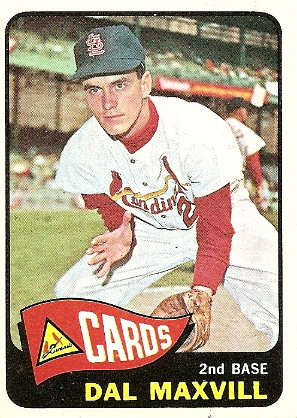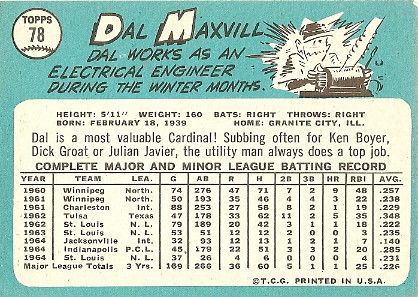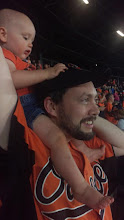
Dal Maxvill was your quintessential all-field, no-hit infielder. Hailing from Granite City, just over the Illinois border from St. Louis, he stayed close to home by attending and graduating from Washington University. The Cardinals signed the local boy in 1960, and he made the big time just two years later. As I've suggested, he wasn't exactly a big-time bat; he hit .217 for his career and never topped .253 for a season. After hitting a three-run home run off of Al Jackson of the Mets in his 46th game as a rookie, Dal would not go deep again for five years. His career total of six longballs in 14 seasons paled in comparison to teammate (and pitcher) Bob Gibson's total of 24. No wonder Cards fans used to call for Gibson to bat ahead of Maxvill in the order!
In 1964, Dal spent three months at midseason back in the minors, but contributed to the eventual world champions with his strong glove at the beginning and end of the season. In thirty games (mostly at second base and shortstop), he committed just one error. He played in all seven World Series games, batting .200 with a double and an RBI. It would be his high-water mark as a postseason hitter. He returned to the Fall Classic with St. Louis in 1967, and again they were victorious in seven games. Maxvill batted a robust .158.
1968 represented both a high and a low in Dal's career. He had his best all-around season, hitting .253 with 52 walks in a pitcher-dominated year and earning a Gold Glove for his play at shortstop. He appeared far down the MVP ballot, as teammate Bob Gibson won the honor comfortably. The Redbirds hoped to repeat as world champs, but Tigers pitcher Mickey Lolich had other ideas. He won three games, and Detroit downed St. Louis in seven. Maxvill wore a pair of goat horns, going 0-for-22 to set a new record for World Series futility.
The infielder seemed to carry his offensive struggles with him into the 1969 campaign, when he hit .175 in 372 at-bats. The following year, he set another dubious mark by managing only 80 hits, the fewest for a position player in 150 or more games. He barely topped the Mendoza line (.201) by virtue of his somewhat-limited 399 at-bats. Maxvill did rebound somewhat from 1971-1972, hitting .225 and .224.
The last few years of his career (1972-1975), Dal bookended a stint in Pittsburgh with two separate stays in Oakland. He won two more World Series with the A's (1972 and 1974), but did not bat once in either series. In fact, former Athletics manager Dick Williams instituted a bizarre platoon for the 1972 pennant race. He had four men on his roster who were quite capable of playing second base (Maxvill, Tim Cullen, Ted Kubiak, and Dick Green), but none of them were very strong hitters. So he would start one of them at second base, and pinch hit for him with a more skilled batsman like Don Mincher. The next time Oakland took the field, another second baseman would pick up his glove. Williams often cycled through all four infielders in the course of one game! Question his tactics if you like, but the skipper is a Hall of Famer.
Maxvill remained in baseball, first as a coach for the A's, Cardinals, Mets, and Joe Torre's Braves, and later as the general manager of the Redbirds (1985-1994). The team won two National League pennants (1985 and 1987), falling in hotly contested World Series to the Royals and Twins, respectively.
Fun fact: Despite totaling a half-dozen round-trippers for his career, Dal hit the first MLB home run in Canada. It was a grand slam off of the Expos' Larry Jaster on April 14, 1969.



As someone who carefully collected the '65 set as a 10 year old---I would bet that is coach Joe Schultz in the background based on his build.
ReplyDeleteThis is one of the all time great Topps sets.
he is the tastefully named dal maxvill...
ReplyDeleteAnon - I forgot Joe Schultz was a coach for St. Louis! We should all pound a Budweiser in his honor.
ReplyDeleteJacob - Yes...Dal "Beta" Maxvill.